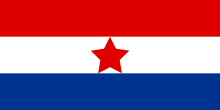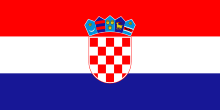- Marjane, Marjane
-
"Marjane, Marjane" (lit. "Marjan, Marjan") is a Croatian song from Dalmatia. The name refers to the Marjan hill which overlooks the capital of Dalmatia, the city of Split, and on which the main (large) city flag is raised. It originates from a folk song sung in the city during the late 1930s, which was first recorded by the poet Ivo Tijardović.[1]
During World War II the song (with somewhat expanded wording) became very popular among the Yugoslav Partisans. The original song was also played on the radio of the Nazi-puppet Independent State of Croatia, the Croatian Radio (Hrvatski krugoval).[2] The original lyrics serve as the official festive song of the city of Split. The song, being traditional, does not have a strictly defined ending, so its ending has changed through time and ideologies. Numerous artists have recorded the song. Najbolji Hrvatski Tamburaši included it in their 1989 release Hrvatska pjesmarica.[3] Trio Gušt released a version with new lyrics in 2009.[4]
Contents
Original (core) lyrics
Croatian English translation Marjane, Marjane, Marjane, Marjane,
Marjane, Marjane, ča barjak ne viješ,
ča barjak ne viješ, ča barjak ne viješ,
ča barjak ne viješ, milu trobojnicu.Milu trobojnicu, milu trobojnicu,
milu trobojnicu, crven, bijeli, plavi,
crven, bijeli, plavi, crven, bijeli, plavi,
crven, bijeli, plavi, to je barjak pravi.Marjan, Marjan, Marjan, Marjan,
Marjan, Marjan, why don't you fly a flag,
Why don't you fly a flag, why don't you fly a flag,
Why don't you fly a flag, the dear tricolour.Dear tricolour, dear tricolour,
Dear tricolour, red, white, blue,
Red, white, blue, red, white, blue,
Red, white, blue, that's the right flag.Historical full versions
Partisan version
Croatian English translation Marjane, Marjane, Marjane, Marjane,
Marjane, Marjane, ča barjak ne viješ,
ča barjak ne viješ, ča barjak ne viješ,
ča barjak ne viješ, milu trobojnicu.Na kojon se čita, na kojoj se čita
Na kojon se čita, ime druga Tita.
A na drugoj strani, a na drugoj strani,
A na drugoj strani, naprid Partizani!A na vrh barjaka, a na vrh barjaka
A na vrh barjaka, zvizda petokraka!Tko se pod njim bije, tko se pod njim bije,
tko se pod njim bije, kukavica nije,
a 'ko se ne bije, a 'ko se ne bije,
a 'ko se ne bije, bolje da ga nije.I još jedno slovo, i još jedno slovo,
I još jedno slovo, ime Staljinovo
I još jedna bratska, i još jedna bratska
I još jedna bratska, živila Hrvatska!Živila sloboda, živila sloboda,
živila sloboda, Hrvatskog naroda!.Marjan, Marjan, Marjan, Marjan,
Marjan, Marjan, why don't you fly the flag,
Why don't you fly the flag, why don't you fly the flag,
Why don't you fly the flag, the dear tricolour.On which it reads, on which it reads
On which it reads, the name of comrade Tito.
And on the other side, and on the other side,
And on the other side, "forward Partisans"!And on the top of the flag, and on the top of the flag,
And on the top of the flag, the five-pointed star.They who fight beneath it, they who fight beneath it,
They who fight beneath it, are not cowards,
And they who don't, and they who don't,
And they who don't, better they not be.And another thing, and another thing,
And another thing, the name of Stalin
And another brotherly, and another brotherly
And another brotherly, long live Croatia!Long live the freedom, long live the freedom,
long live the freedom of the Croatian people!In later versions, from the beginning of the Informbiro period (1948–1955) to the dissolution of Yugoslavia in 1991 with the Yugoslav wars, the stanza with the reference to Stalin was no longer popular and became used less and less. It was revived in the 1970s nationalist version, with "Jesus" replacing "Stalin" in the wording. The first two stanzas of this version are featured in the Academy Award-nominated motion picture The Battle of Neretva.[5]
Nationalist version
Croatian English translation Marjane, Marjane, Marjane, Marjane,
Marjane, Marjane, ča barjak ne viješ,
ča barjak ne viješ, ča barjak ne viješ,
ča barjak ne viješ, milu trobojnicu.Milu trobojnicu, milu trobojnicu,
milu trobojnicu, crven, bili, plavi,
crven, bili, plavi, crven, bili, plavi,
crven, bili, plavi, to je barjak pravi.Pod kojim su pali, pod kojim su pali,
pod kojim su pali Zrinski-Frankopani.
Za kojim se hvali, za kojim se hvali,
za kojim se hvali, cila Dalmacija!Tko se pod njim bije, tko se pod njim bije,
tko se pod njim bije, kukavica nije,
a 'ko se ne bije, a 'ko se ne bije,
a 'ko se ne bije, bolje da ga nije.I još jedno slovo, i još jedno slovo,
I još jedno slovo, ime Isusovo
I još jedna bratska, i još jedna bratska
I još jedna bratska, živila Hrvatska!Živila sloboda, živila sloboda,
živila sloboda, Hrvatskog naroda!.Marjan, Marjan, Marjan, Marjan,
Marjan, Marjan, why don't you fly the flag,
Why don't you fly the flag, why don't you fly the flag,
Why don't you fly the flag, the dear tricolour.Dear tricolour, dear tricolour,
Dear tricolour, red, white, blue,
Red, white, blue, red, white, blue,
Red, white, blue, that's the right flag.Under which did fall, under which did fall,
under which did fall, the Zrinski-Frankopans.
For whom thanks, for whom thanks,
for whom thanks all Dalmatia.They who fight beneath it, they who fight beneath it,
They who fight beneath it, are not cowards,
And they who don't, and they who don't,
And they who don't, better they not be.And another thing, and another thing,
And another thing, the name of Jesus
And another brotherly, and another brotherly
And another brotherly, long live Croatia!Long live the freedom, long live the freedom,
long live the freedom, of the Croatian people!This is the version more widely known in post-1989 Croatia[6][7]. One of its first large scale performances was on May 30, 1990 by the Dalmatian Croat Duško Lokin[8]. It is often sung by Torcida, the supporters of the Split football club, HNK Hajduk.[9]
Some of the verses of this version contain historical inaccuracies. The 17th century Croatian noblemen Petar Zrinski and Fran Krsto Frankopan, the main Croatian actors of the Magnate conspiracy, were noblemen of the Habsburg Monarchy while Split was for centuries a part of the Venetian Republic (and would remain outside the Monarchy for more than a hundred years after their death). Both feudal noblemen never saw Split and had little to do with the city. Furthermore, they did not fall under the red, white and blue Croatian banner, and their participation in the Magnate conspiracy was not an attempt to liberate or in any way assist Dalmatia and/or its Croat population under Venetian rule. In fact, the red, white and blue Croatian flag was not invented for another cca. 160 years after their execution, and the Venetian Republic was one of their potential allies against the Holy Roman Emperor and King, Leopold I.
See also
References
- ^ Slobodna Dalmacija
- ^ Tomislav Jonjić, Jadranske teme u Hrvatskom narodu od travnja 1941. do rujna 1943.. Časopis za suvremenu povijest, no. 3, 911-932 (2008)
- ^ Hrvatska pjesmarica - 1989 - Najbolji Hrvatski Tamburaši (Zlatni Dukati)
- ^ Trio Gušt oživio Marjane, Marjane...
- ^ YouTube - Yul Brynner & Marjane, Marjane - Battle of the river Neretva
- ^ Marjane, Marjane
- ^ http://www.google.ca/search?q=%22marjane+marjane%22&start=0&ie=utf-8&oe=utf-8&client=firefox-a&rls=org.mozilla:en-US:official
- ^ YouTube - DUŠKO LOKIN MARJANE,MARJANE 30 SVIBNJA 1990
- ^ http://www.hnkhajduk.com/index.php? option=com_content&task=view&id=22&Itemid=35
External links
Categories:- Croatian songs
- Split
Wikimedia Foundation. 2010.



